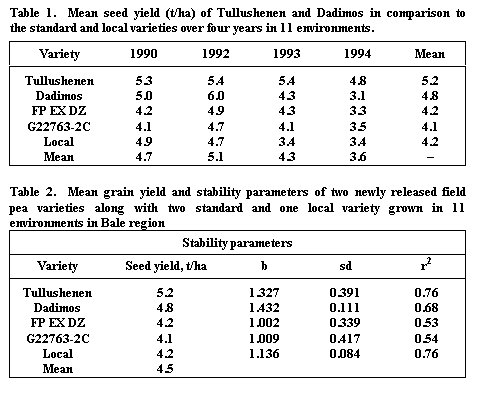Two new field pea cultivars for the southeastern highlands of Ethiopia
Getachew,
T.
Sinana Research Center
P.O. Box 208, Bale-Robe, Ethiopia
Introduction
Field pea is the first ranking food legume in Bale region.
It is planted in rotation with barley and wheat
(Alemayehu and Steven, 1987). Field
pea grows twice a year during “belg” (March to July) and “meher” (July
to December). Grain harvest by
small farmers falls between 4-6 and 2-3 t/ha in belg and meher seasons
respectively around Sinana (1). Aphids,
low yielding a local varieties, lodging, diseases (powdery and downy mildew),
and pod shattering are the major production constraints to field pea production
in Bale in that order of importance. Sometimes
aphids and variety are interchangeable.
Dadimos and Tullushenen are new field pea cultivars adapted to the
southeastern highlands of Ethiopia, developed by Sinana Research Center through
its regional breeding program. They
are high yielding and medium maturing (140-145 days) with high protein content.
Selection
 Both lines were acquired from Holetta Research Center in 1988. Fifteen plants from each line were picked before harvesting
and were bulk planted in 1989. These
selected lines were screened for yield and agronomic traits in a simple lattice
design in 1990, 1992, 1993 and 1994 in a multi-location yield test within the
Bale region at major pea growing areas. They
were evaluated together with other test entries in a total of eleven
environments. The elite lines with
the designation, 161K-2P-11/3/3(B) and PGRC/E 32121-1(B) were named DADIMOS and
TULLUSHENEN respectively after official release for commercial production by the
national seed release committee.
Both lines were acquired from Holetta Research Center in 1988. Fifteen plants from each line were picked before harvesting
and were bulk planted in 1989. These
selected lines were screened for yield and agronomic traits in a simple lattice
design in 1990, 1992, 1993 and 1994 in a multi-location yield test within the
Bale region at major pea growing areas. They
were evaluated together with other test entries in a total of eleven
environments. The elite lines with
the designation, 161K-2P-11/3/3(B) and PGRC/E 32121-1(B) were named DADIMOS and
TULLUSHENEN respectively after official release for commercial production by the
national seed release committee.
Grain Yield Performance
The two newly released field pea varieties exhibited consistently good
yield, as indicated by their mean yields (Tables 1 and 2).
Data from yield trials in the 11 environments during the last four
seasons (1991-1994) showed that the grain yield advantages of new cultivars
Dadimos and Tullushenen were 14 and 24% over that of the local varieties.
Stability analysis was done as per Eberhard and Russell (2).
The coefficient of regression (b) value for both the new varieties was
above one indicating that they are productive in favorable environments.
This con clusion is in agreement with Saeed et al. (3).
A cultivar with high mean performance and b value higher than 1.0 would
indicate that it is expected to respond with high yield to favorable
environmental conditions and can thus take advantage of the best agronomic
treatments that can be applied or the best growing seasons.
In the multi-location test over four years Tullushenen and Dadimos gave
an average yield of 5.2 t/ha and 4.8 t/ha respectively compared with 4.2 t/ha
for the local check.
clusion is in agreement with Saeed et al. (3).
A cultivar with high mean performance and b value higher than 1.0 would
indicate that it is expected to respond with high yield to favorable
environmental conditions and can thus take advantage of the best agronomic
treatments that can be applied or the best growing seasons.
In the multi-location test over four years Tullushenen and Dadimos gave
an average yield of 5.2 t/ha and 4.8 t/ha respectively compared with 4.2 t/ha
for the local check.
Grain Quality
Tullushenen has a higher protein content (25.6%) than the two standard
and the local variety. Dadimos has also comparable protein content (23.6%) with the
standard and the local varieties (Table 3).
Moreover, the seeds of Dadimos and Tullushenen are, respectively, 54% and
19% larger than the local (Table 3). Dadimos
has white colored seeds so it has a premium price in the local as well as export
markets.
Acknowledgement: I very much appreciate the cooperation extended by Holetta Research
Center through Dr. Asfaw Telaye the former Ethiopian National Legume program
leader and Dr. Yohannes Degago the present Legume Program leader for the supply
of germplasm and interations without which the release of these varieties would
not have been possible.
1.
Mamo, A. and Franzel, S. 1987.
Sinana mixed farming systems zone. Working
paper No. 1, Bale region.
2.
Eberhard, S.A. and Russell, W.A. 1966.
Crop Sci. 6: 36-40.
3. Saeed,
M., Francis, C.A., Rajewski, J.F. and Maranville, J.W. 1987. Crop Sci.
27: 169-171.
 Both lines were acquired from Holetta Research Center in 1988. Fifteen plants from each line were picked before harvesting
and were bulk planted in 1989. These
selected lines were screened for yield and agronomic traits in a simple lattice
design in 1990, 1992, 1993 and 1994 in a multi-location yield test within the
Bale region at major pea growing areas. They
were evaluated together with other test entries in a total of eleven
environments. The elite lines with
the designation, 161K-2P-11/3/3(B) and PGRC/E 32121-1(B) were named DADIMOS and
TULLUSHENEN respectively after official release for commercial production by the
national seed release committee.
Both lines were acquired from Holetta Research Center in 1988. Fifteen plants from each line were picked before harvesting
and were bulk planted in 1989. These
selected lines were screened for yield and agronomic traits in a simple lattice
design in 1990, 1992, 1993 and 1994 in a multi-location yield test within the
Bale region at major pea growing areas. They
were evaluated together with other test entries in a total of eleven
environments. The elite lines with
the designation, 161K-2P-11/3/3(B) and PGRC/E 32121-1(B) were named DADIMOS and
TULLUSHENEN respectively after official release for commercial production by the
national seed release committee.
